Anybody who thinks that the British motorcycle industry was blind-sided by the invasion of Japanese motorcycles has not read his or her history.
Lots of people in England were working on new ideas in the early ’60s, but the problem was more a lack of investment than any lack of engineering, and secondarily a number of higher-up execs who really had little idea as to what the motorcycling industry was all about.
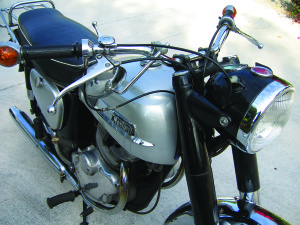
The motorcyclists in the R&D departments in the late ’50s understood that practicality was going to run second place to fun in the future, and sporty bikes like the Triumph Bonneville would sell well. At the opposite end of the spectrum was the new-rider market, but this was one which would soon show its desire to get away from some of the complications of riding, like having to jump up and down on a kickstarter. No fun, that; much easier to push a button on a Japanese bike.
This Norton Electra 400 appeared at the London Motorcycle Show late in 1962, a very neat unit-construction twin with short pushrods, an integrated four-speed transmission—and an electric starter. This particular model was not meant for sale in England, as it had been requested by the American Norton importer, Joe Berliner, who wanted to compete with Honda’s 305 that was selling like the proverbial hotcakes.
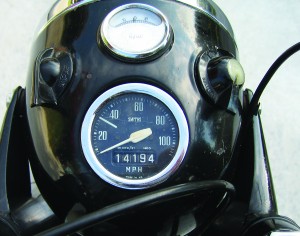
A brief background: Norton was noted for its OHV and OHC singles until the Model 7 twin came along after World War II, when everybody was copying Edward Turner’s vertical twin design originally seen on the Triumph. The 500cc Model 7 became the Featherbed-framed Dominator 88 and the 600cc 99, but
to celebrate Norton’s 60th anniversary in 1958 the company decided to go small and appeal to the beginning rider, restricted by law to 250cc, with the 250 Jubilee twin, using a new parallel four-stroke twin engine of unit construction. Norton had long been known for its manly machines, and this quarter-liter version was quite a shift, undersizing even Triumph’s 350cc twin.
However, while the engine was new, the rest of the bike was cobbled together out of parts bins. Norton had been absorbed into Associated Motor Cycles in 1953, which included AJS, Matchless and the Francis Barnett two-strokes, and the decision was to use chassis components from the lightweight Fanny B.
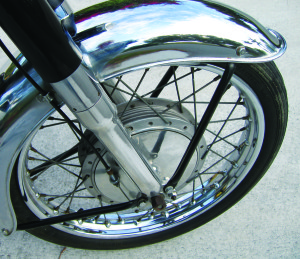
So while it had the Norton tank and mufflers, the rather spindly fork detracted from its manliness, and the small 6-inch brakes fore and aft did not breathe “speed.” However, it handled quite well, and did put out 16 horses, far better than the anemic 11 ponies coming from BSA’s 250 single.
Unfortunately, the British still liked to split the crankcases vertically rather than horizontally, which inevitably involved oil leaks.
In 1960 the Jubilee was bored and stroked to 349cc, and the Navigator was introduced. The frame got reinforced, and Norton’s famous Roadholder forks were used, along with an 8-inch full-hub front brake that was also seen on the Dominator series.
Berliner saw this, and looked over at what was making for Honda’s success, and realized that a large number of newcomers to the sport were not at all interested in kickstarting their motorcycles—when they could just push a button. Since the United States was a major consumer of Nortons he had some clout, and in 1962 asked if the factory couldn’t put an electric starter on the Navigator. Heck, Lucas even had the starter, the M3 unit.
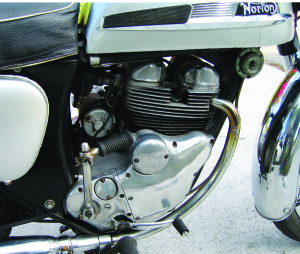
Not a problem, Joe, said the factory, we’ll look at the situation. That M3 can fit right under the Amal carburetor, on top of the transmission, with a chain connecting it to the left end of the crankshaft, outboard of both the primary chain and the alternator. That six-volt battery under the seat won’t have enough juice, but we can slip a second battery in the left-side toolbox and hook them in series. All we would have to do then is to cast a new sidecover—and that would only increase the width of the engine by a mere inch and a quarter. Simple! Joe, you’ll have it next year.
A few other changes were made, including boring the engine to 384cc to give it a new numeric designation. Originally the engine was supposed to be stroked as well to 397cc, and Berliner in 1963 gave the 397cc figure, but it never really was. Since the estimated power had gone to 25 horses at 6,800 rpm, this meant strengthening the gearbox and the clutch, more gussets welded on the frame, and putting the Dominator’s 7-inch full-hub brake on the rear wheel. With 3.5 gallons of gas in the tank, the Electra weighed just over 350 pounds.
The first lot went straight to Berliner, who found that his manly buyers were far more interested in kickstarting the 750cc Atlas than in pushing that 400’s button. The starter worked OK, not great. On cold mornings riders learned to use the kickstarter to turn the engine a few times before pushing the button.
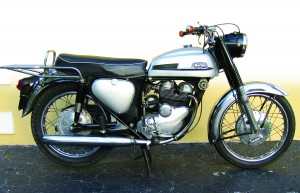
Handling was adequate, but not a patch on the Featherbed models. The Electra continued the lovely British tradition of leaving little puddles of oil wherever it was parked. It was not a resounding sales success, mainly due to the fact that the new riders, the ones who did not want to exert themselves unnecessarily by using a kickstarter, really liked the Japanese approach of building a unified motorcycle, not one put together out of spare parts in an effort to save money.
Since Berliner was not buying the entire output as had been presupposed, the Electra soon became available on the British market as the ES400. It was way overpriced, costing more than some 500 twins. AMC was struggling with finances, desperately needing a bail-out. The Electra was cut from the list after 1965—and 10 years later the 1975 Commando 850 Mark III appeared with an electric starter, that same M3 unit, the second Norton model to have the battery-powered leg.
(This Retrospective article was published in the July 2009 issue of Rider magazine.)








I have same bike, serial # EL 437. Year of this bike ?
I have a EL 741 that’s a 1964
It’s a great piece of fiction as Honda didn’t have an Estart on any of their US bikes until 68. That was on the 305 and it was problematic. In 69 the new 750 came with an Estart that worked.
So back in the 50s and early 60s people were not ” pushing the Estart button” on Hondas as the article suggests.
I had a 64… EL402
I Thought it was a great bike.